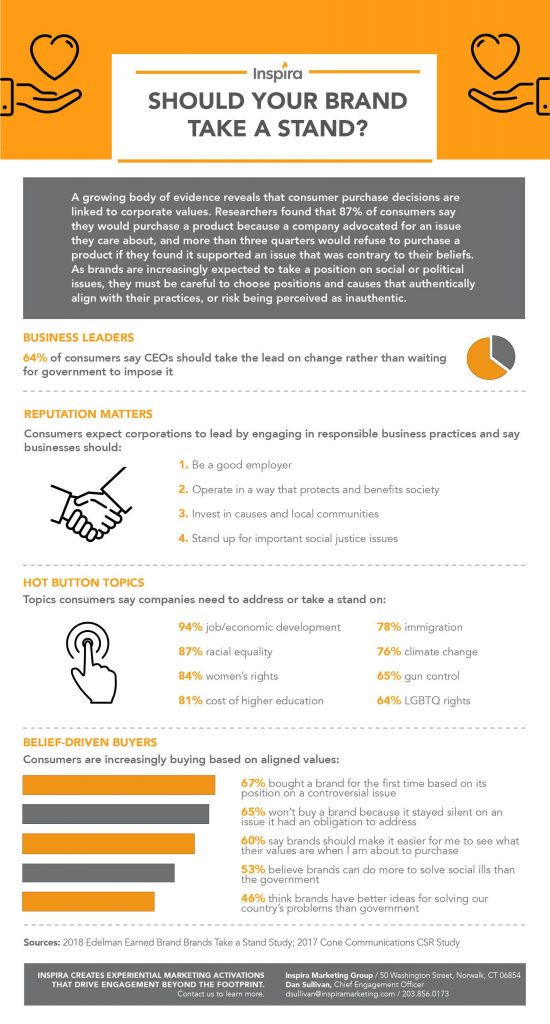
FOUNDATION
Cause Market Like a Boss
June 3, 2021 | Education
Have you enjoyed a pink cocktail in October because of Breast Cancer Awareness Month? Or have you purchased a rainbow-adorned t-shirt for Pride Month? If so, you have participated in a cause marketing campaign.
As defined by Small Business Trends, cause-related marketing is when a business supports a charitable cause or a social issue and gets marketing (and monetary) benefits.
With a saturated market, brands will look for anything for a competitive edge. We live in the consumer’s age, and a companies’ need to differentiate itself from competitors is crucial for business survival – hence the increase of cause marketing initiatives.
Brandwatch summarized a global study that reported 91% of consumers said they were likely to switch to a brand that supports a good cause, given similar price and quality. 92% said they would buy a product with a social or environmental benefit given the opportunity, and 67% said they had done so in the past 12 months.
Interested in pursuing a cause marketing campaign? Fantastic. Brands have an excellent platform to make a difference but tread carefully. A poorly executed initiative could lead to a PR nightmare and permanent damage to a company’s reputation.
Here are tips on how to execute cause marketing campaigns successfully and authentically.
Make Sure Your Cause Fits Your Brand
One of the most significant cause marketing hiccups involved a fast-food chain and breast cancer awareness. While the campaign led to a multi-million-dollar charitable donation, there was massive confusion over what fast food has to do with breast cancer research. Especially since consuming a considerable amount could lead to health risks linked to cancer.
At the time, Barbara Brenner, executive director of Breast Cancer Action, said, “they are raising money for women’s health by selling a product that’s bad for your health … it’s hypocrisy.”
Visit Engage for Good to view webinars on various cause marketing-related topics and dig deeper to figure out the right cause for your brand.
Designate a Charity to Make a Donation
As the expression goes, “put your money where your mouth is.” If you use a cause to generate sales, you should “compensate” that issue. Think of it as paying someone for their image or endorsement.
Once you’ve designated an entity to make a contribution to, contact that organization and give someone the heads up. ASK PERMISSION TO USE ANY BUSINESS’ LOGO OR NAME BEFORE INCORPORATING IT.
This Is Personal…and Business
Your cause should represent the essence of your brand.
As mentioned in our blog post “Embracing Culture and Choosing to Educate Despite Discrimination,” Chitra Agrawal’s Indian heritage inspired her to start Brooklyn Delhi, a marketplace of condiments and sauces inspired by Indian culinary traditions. Recognizing the devastation and suffering in the country resulting from COVID-19, Agrawal decided to donate 50% of Brooklyn Delhi’s proceeds from May 2021 to support relief efforts.
Another example is Sandcloud, a San Diego-based company that sells sustainable products, including towels, drawstrings, water bottles, and reusable straws. As part of its mission, 10% of profits are donated to marine conversation efforts.
Do More
Yes, money is great but providing information and volunteering sends a strong message that this cause is important. Tell your consumers why a cause or an issue is worth supporting. This could be as simple as including an insert in an order fulfillment about the charity or cause being supported. Always provide consumers a way to learn more and seek additional resources.
Additionally, cause-marketing campaigns are a great way to engage employees. If you are selling a cupcake and part of the proceeds are going to a food bank, organize a volunteer opportunity for staff members to deliver meals to those in need. You are doing something incredible. Enable others to do something good as well.
Commit Year Round
There is usually a rise in cause marketing efforts during specific points of the year. For example, companies might sell a rainbow pillow with proceeds benefiting LGBTQ+ causes in June as part of Pride Month. However, the company makes no mention of the issue for the rest of the year. Does the LGBTQ+ community only exist in June? No. Does pediatric cancer only occur in September? No. And neither should your campaigns.
If this is a cause that really speaks to your company’s mission, think strategically about ways to reinforce the message throughout this year. This can be done through regular e-mail updates, social media posts, and local advocacy work.
The Conscious Consumer Is Here to Stay
Our friends at Inspira Marketing created the following infographic that drills down the need for businesses to take a stand and use their platform to make a difference.
Sign Up For Our Newsletter


